Assessment of High Performance Self-Consolidating Concrete through an Experimental and Analytical Multi-Parameter Approach
Abstract
1. Introduction
2. Material and Methods
2.1. Material Properties
2.2. Mix Types and Mix Proportions
2.3. Testing Fresh Concrete Properties
2.4. Testing Physical Properties of Hardened Concrete
2.5. Testing of Mechanical Properties
2.6. Durability Tests of the Concrete Mixes
2.7. Economic Assessment of the Concrete Mixes
3. Results and Discussions
3.1. Slump Test
3.2. Flow Test
3.3. Restricted Flow Test
3.4. Density of the Hardened Concrete
3.5. Water Absorption by Immersion
3.6. Compressive Strength
3.7. Splitting Tensile Strength
3.8. Flexural Strength
3.9. Stress-Strain Relationships
3.10. Modulus of Elasticity
3.11. Oven Heating Test
3.12. Fire Resistance Test
3.13. Freezing and Thawing Cycles
3.14. Scaling Test
4. Hexagonal Model for Cost–Strength–Workability–Durability Relationship
5. Conclusions
- i.
- HPSCC exhibited excellent workability and flowability compared to NSVC and HPVC mixes that need vibration or compaction effort, hence, HPSCC is eco-friendly and beneficial for the environment by using sustainable materials like micro-silica and fly ash.
- ii.
- The density of the HPSCC was almost in the range of normal concretes, whereas the absorption of HPSCC was less than one half of both HSSCC and NSVC.
- iii.
- HPSCC was an early strength-gaining concrete by obtaining 20.9 MPa of compressive strength in one day, and 100.2 MPa at 90 days, which is higher than that of NSVC and HSSCC by 86.9% and 20.9%, respectively. The tensile strength of HPSCC from both splitting tensile strength and flexural resistance was much higher than the two mentioned mixes. Thus, due to its strength HPSCC can be useful in decreasing structural section sizes, and thereby the amount of concrete and cement used in construction projects.
- iv.
- HPSCC showed an elastic modulus of 42.7 GPa and had better resistance to the compressive strains and deformation, compared to those of NSVC and HSSCC. The relationship of the stress-strain curves was linear for HPSCC up to 80% of the ultimate load, while the curve for NSVC was starting deviation from linearity in an earlier stage of about 40% of the applied load.
- v.
- When exposed to fire flame or high temperature of 700 °C for 2 h, HPSCC behaved as a durable concrete, and had a residual strength of 48.2%, while the residual strength of NSVC and HSSCC were 21.4% and 37.3%, respectively. So, during fire accidents, HPSCC can survive more, and the probability of demolishing after the fire and new construction is much less.
- vi.
- Freeze-thaw 50 cycles were causing degradation in the compressive strength of HPSCC by only 9.7%, while the strength loss of NSVC and HSSCC was 85.6% and 36.8% respectively. In the scaling test, the average thickness losses for HPSCC were almost negligible, while the thickness loss of NSVC and HSSCC was 8 mm and 1 mm, respectively.
- vii.
- The proposed hexagonal comparison model can successfully predict the most beneficial concrete mixes, considering workability, strength, cost, and durability.
Author Contributions
Funding
Institutional Review Board Statement
Informed Consent Statement
Data Availability Statement
Acknowledgments
Conflicts of Interest
References
- Łaźniewska-Piekarczyk, B. The influence of chemical admixtures on cement hydration and mixture properties of very high performance self-compacting concrete. Constr. Build. Mater. 2013, 49, 643–662. [Google Scholar] [CrossRef]
- Pineaud, A.; Pimienta, P.; Rémond, S.; Carre, H. Mechanical properties of high performance self-compacting concretes at room and high temperature. Constr. Build. Mater. 2016, 112, 747–755. [Google Scholar] [CrossRef]
- Łaźniewska-Piekarczyk, B. Effect of viscosity type modifying admixture on porosity, compressive strength and water penetration of high performance self-compacting concrete. Constr. Build. Mater. 2013, 48, 1035–1044. [Google Scholar] [CrossRef]
- Farooq, F.; Rahman, S.K.U.; Akbar, A.; Khushnood, R.A.; Javed, M.F.; Alyousef, R.; Alabduljabbar, H.; Aslam, F. A comparative study on performance evaluation of hybrid GNPs/CNTs in conventional and self-compacting mortar. Alex. Eng. J. 2020, 59, 369–379. [Google Scholar] [CrossRef]
- Noumowé, A.; Carre, H.; Daoud, A.; Toutanji, H. High-strength self-compacting concrete exposed to fire test. J. Mater. Civ. Eng. 2006, 18, 754–758. [Google Scholar] [CrossRef]
- Ahmad, S.; Umar, A.; Masood, A. Properties of normal concrete, self-compacting concrete and glass fibre-reinforced self-compacting concrete: An experimental study. Procedia Eng. 2017, 173, 807–813. [Google Scholar] [CrossRef]
- Kang, S.-H.; Hong, S.-G.; Moon, J. Shrinkage characteristics of heat-treated ultra-high performance concrete and its mitigation using superabsorbent polymer based internal curing method. Cem. Concr. Compos. 2018, 89, 130–138. [Google Scholar] [CrossRef]
- Łaźniewska-Piekarczyk, B. Investigations on the relationship between porosity and strength of admixtures modified high performance self-compacting concrete. J. Civ. Eng. Manag. 2016, 22, 520–528. [Google Scholar] [CrossRef]
- Wilson, M.; Kosmatka, S. Design and Control of Concrete Mixtures, 15th ed.; Portland Cement Association: Skokie, IL, USA, 2011. [Google Scholar]
- Duran-Herrera, A.; De-León-Esquivel, J.; Bentz, D.; Valdez-Tamez, P. Self-compacting concretes using fly ash and fine limestone powder: Shrinkage and surface electrical resistivity of equivalent mortars. Constr. Build. Mater. 2019, 199, 50–62. [Google Scholar] [CrossRef]
- Aggarwal, P.; Siddique, R.; Aggarwal, Y.; Gupta, S.M. Self-compacting concrete-procedure for mix design. Leonardo Electron. J. Pract. Technol. 2008, 12, 15–24. [Google Scholar]
- Kumar, P.; Kumar, R.; Gupta, K. Study on Normally Vibrated Concrete to Self-Compacting Concrete. J. Ceram. Concr. Technol. 2016, 1, 1–18. [Google Scholar]
- Boel, V.; Audenaert, K.; de Schutter, G. Gas permeability and capillary porosity of self-compacting concrete. Mater. Struct. 2008, 41, 1283–1290. [Google Scholar] [CrossRef]
- Caldarone, M.A.; Taylor, P.C.; Detwiler, R.J.; Bhidé, S.B. Guide Specification for High Performance Concrete for Bridges; Portland Cement Association: Skokie, IL, USA, 2005. [Google Scholar]
- Zhutovsky, S.; Kovler, K. Influence of water to cement ratio on the efficiency of internal curing of high-performance concrete. Constr. Build. Mater. 2017, 144, 311–316. [Google Scholar] [CrossRef]
- Aziz, O.Q.; Ahmed, G.H. Mechanical properties of ultra-high performance concrete (UHPC). In Proceedings of the 12th International Conference on Recent Advances in Concrete Technology and Sustainability Issues, Prague, Czech Republic, 31 October–2 November 2012; American Concrete Institute, ACI Special Publication: Prague, Czech Republic, 2012; pp. 1–16. [Google Scholar]
- Wang, D.; Shi, C.; Wu, Z.; Xiao, J.; Huang, Z.; Fang, Z. A review on ultra high performance concrete: Part II. Hydration, microstructure and properties. Constr. Build. Mater. 2015, 96, 368–377. [Google Scholar] [CrossRef]
- Afroughsabet, V.; Biolzi, L.; Ozbakkaloglu, T. Influence of double hooked-end steel fibers and slag on mechanical and durability properties of high performance recycled aggregate concrete. Compos. Struct. 2017, 181, 273–284. [Google Scholar] [CrossRef]
- Nadeem, A.; Memon, S.A.; Lo, T.Y. The performance of fly ash and metakaolin concrete at elevated temperatures. Constr. Build. Mater. 2014, 62, 67–76. [Google Scholar] [CrossRef]
- Kurda, R.; de Brito, J.; Silvestre, J.D. CONCRETop method: Optimization of concrete with various incorporation ratios of fly ash and recycled aggregates in terms of quality performance and life-cycle cost and environmental impacts. J. Clean. Prod. 2019, 226, 642–657. [Google Scholar] [CrossRef]
- de Brito, J.; Kurda, R. The past and future of sustainable concrete: A critical review and new strategies on cement-based materials. J. Clean. Prod. 2021, 281, 123558. [Google Scholar] [CrossRef]
- de Brito, J.; Kurda, R. Low Binder Concrete and Mortars. Appl. Sci. 2020, 10, 3866. [Google Scholar] [CrossRef]
- Memon, S.A.; Shah, S.F.A.; Khushnood, R.A.; Baloch, W.L. Durability of sustainable concrete subjected to elevated temperature–A review. Constr. Build. Mater. 2019, 199, 435–455. [Google Scholar] [CrossRef]
- Seleem, H.E.D.H.; Rashad, A.M.; Elsokary, T. Effect of elevated temperature on physico-mechanical properties of blended cement concrete. Constr. Build. Mater. 2011, 25, 1009–1017. [Google Scholar] [CrossRef]
- Hamzah, A.F.; Ibrahim, M.W.; Jamaluddin, N.; Jaya, R.; Abidin, N.E.Z. Cementitious materials usage in self-compacting concrete: A review. Adv. Mater. Res. 2015, 1113, 153–160. [Google Scholar] [CrossRef]
- Sfikas, P. Self-compacting concrete: History and current trends. Concrete 2017, 51, 12–16. [Google Scholar]
- Dybeł, P.; Wałach, D.; Ostrowski, K. The top-bar effect in specimens with a single casting point at one edge in high-performance self-compacting concrete. J. Adv. Concr. Technol. 2018, 16, 282–292. [Google Scholar] [CrossRef]
- Megid, W.A.; Khayat, K.H. Effect of concrete rheological properties on quality of formed surfaces cast with self-consolidating concrete and superworkable concrete. Cem. Concr. Compos. 2018, 93, 75–84. [Google Scholar] [CrossRef]
- El-Chabib, H.; Syed, A. Properties of self-consolidating concrete made with high volumes of supplementary cementitious materials. J. Mater. Civ. Eng. 2013, 25, 1579–1586. [Google Scholar] [CrossRef]
- Sideris, K.K.; Tassos, C.; Chatzopoulos, A.; Manita, P. Mechanical characteristics and durability of self compacting concretes produced with ladle furnace slag. Constr. Build. Mater. 2018, 170, 660–667. [Google Scholar] [CrossRef]
- Kostrzanowska-Siedlarz, A.; Gołaszewski, J. Rheological properties of high performance self-compacting concrete: Effects of composition and time. Constr. Build. Mater. 2016, 115, 705–715. [Google Scholar] [CrossRef]
- Huseien, G.F.; Sam, A.R.M.; Alyousef, R. Texture, morphology and strength performance of self-compacting alkali-activated concrete: Role of fly ash as GBFS replacement. Constr. Build. Mater. 2020, 121368. [Google Scholar] [CrossRef]
- Gholampour, A.; Ozbakkaloglu, T. Performance of sustainable concretes containing very high volume Class-F fly ash and ground granulated blast furnace slag. J. Clean. Prod. 2017, 162, 1407–1417. [Google Scholar] [CrossRef]
- Tufail, M.; Shahzada, K.; Gencturk, B.; Wei, J. Effect of elevated temperature on mechanical properties of high strength concrete. Int. J. Concr. Struct. Mater. 2017, 11, 17–28. [Google Scholar] [CrossRef]
- Olanike, A.O. Experimental Investigation into the Freeze-Thaw Resistance of Concrete Using Recycled Concrete Aggregates and Admixtures. Ratio 2014, 85, 120. [Google Scholar]
- Alyousef, R.; Benjeddou, O.; Khadimallah, M.A.; Mohamed, A.M.; Soussi, C. Study of the Effects of Marble Powder Amount on the Self-Compacting Concretes Properties by Microstructure Analysis on Cement-Marble Powder Pastes. Adv. Civ. Eng. 2018, 2018, 6018613. [Google Scholar] [CrossRef]
- Bogas, J.; Hawreen, A. Capillary Absorption and Oxygen Permeability of Concrete Reinforced with Carbon Nanotubes. Adv. Civ. Eng. Mater. 2019, 8, 1–13. [Google Scholar]
- Hawreen, A.; Bogas, J.A.; Kurda, R. Mechanical Characterization of Concrete Reinforced with Different Types of Carbon Nanotubes. Arab. J. Sci. Eng. 2019, 44, 8361–8376. [Google Scholar] [CrossRef]
- Abu Maraq, M.A.; Tayeh, B.A.; Ziara, M.M.; Alyousef, R. Flexural behavior of RC beams strengthened with steel wire mesh and self-compacting concrete jacketing—Experimental investigation and test results. J. Mater. Res. Technol. 2021, 10, 1002–1019. [Google Scholar] [CrossRef]
- Li, Y.; Pimienta, P.; Pinoteau, N.; Tan, K.-H. Effect of aggregate size and inclusion of polypropylene and steel fibers on explosive spalling and pore pressure in ultra-high-performance concrete (UHPC) at elevated temperature. Cem. Concr. Compos. 2019, 99, 62–71. [Google Scholar] [CrossRef]
- Alyousef, R.; Khadimallah, M.A.; Soussi, C.; Benjeddou, O.; Jedidi, M. Experimental and Theoretical Study of a New Technique for Mixing Self-Compacting Concrete with Marble Sludge Grout. Adv. Civ. Eng. 2018, 2018, 3283451. [Google Scholar] [CrossRef]
- Alabduljabbar, H.; Alyousef, R.; Alrshoudi, F.; Alaskar, A.; Fathi, A.; Mohamed, A.M. Mechanical effect of steel fiber on the cement replacement materials of self-compacting concrete. Fibers 2019, 7, 36. [Google Scholar] [CrossRef]
- Kannan, V.; Jerin, C.; Murali, D.K. A Review on Self Compacting Concrete. Int. J. Adv. Res. Eng. Manag. 2015, 1, 64–68. [Google Scholar]
- Alyousef, R.; Benjeddou, O.; Soussi, C.; Khadimallah, M.A.; Mohamed, A.M. Effects of Incorporation of Marble Powder Obtained by Recycling Waste Sludge and Limestone Powder on Rheology, Compressive Strength, and Durability of Self-Compacting Concrete. Adv. Mater. Sci. Eng. 2019, 2019, 4609353. [Google Scholar] [CrossRef]
- Celik, K.; Meral, C.; Gursel, A.P.; Mehta, P.K.; Horvath, A.; Monteiro, P.J. Mechanical properties, durability, and life-cycle assessment of self-consolidating concrete mixtures made with blended portland cements containing fly ash and limestone powder. Cem. Concr. Compos. 2015, 56, 59–72. [Google Scholar] [CrossRef]
- Ye, G.; de Schutter, G.; Taerwe, L. Study of vapor pressure of high performance concrete and self-compacting concrete slabs subjected to standard fire conditions. In Proceedings of the 2nd International RILEM Workshop on Concrete Spalling due to Fire Exposure, Delft, The Netherlands, 5–7 October 2011; RILEM Publications SARL: Bagneux, France, 2011. [Google Scholar]
- Phan, L.T. High-strength concrete at high temperature-an overview. In Proceedings of the 6th International Symposiumon Utilization of High Strength/High Performance Concrete, Leipzig, Germany, 1 June 2002; pp. 501–518. [Google Scholar]
- Ahmad, S.; Khushnood, R.A.; Jagdale, P.; Tulliani, J.-M.; Ferro, G.A. High performance self-consolidating cementitious composites by using micro carbonized bamboo particles. Mater. Des. 2015, 76, 223–229. [Google Scholar] [CrossRef]
- Manjunath, R.; Narasimhan, M.C.; Kumar, S. Effects of fiber addition on performance of high-performance alkali activated slag concrete mixes: An experimental evaluation. Eur. J. Environ. Civ. Eng. 2020, 1–16. [Google Scholar] [CrossRef]
- Elemam, W.E.; Abdelraheem, A.H.; Mahdy, M.G.; Tahwia, A.M. Optimizing fresh properties and compressive strength of self-consolidating concrete. Constr. Build. Mater. 2020, 249, 118781. [Google Scholar] [CrossRef]
- Ghezal, A.; Khayat, K.H. Optimizing self-consolidating concrete with limestone filler by using statistical factorial design methods. Mater. J. 2002, 99, 264–272. [Google Scholar]
- Sharifi, E.; Sadjadi, S.J.; Aliha, M.; Moniri, A. Optimization of high-strength self-consolidating concrete mix design using an improved Taguchi optimization method. Constr. Build. Mater. 2020, 236, 117547. [Google Scholar] [CrossRef]
- ASTM C1611/C1611M-18. Standard Test Method for Slump Flow of Self-Consolidating Concrete; ASTM International: West Conshohocken, PA, USA, 2018. [Google Scholar]
- ASTM C666/C666M-15. Standard Test Method for Resistance of Concrete to Rapid Freezing and Thawing; ASTM International: West Conshohocken, PA, USA, 2015. [Google Scholar]
- ASTM C672/C672M-12. Standard Test Method for Scaling Resistance of Concrete Surfaces Exposed to Deicing Chemicals; ASTM International: West Conshohocken, PA, USA, 2012. [Google Scholar]
- Hisseine, O.A.; Basic, N.; Omran, A.F.; Tagnit-Hamou, A. Feasibility of using cellulose filaments as a viscosity modifying agent in self-consolidating concrete. Cem. Concr. Compos. 2018, 94, 327–340. [Google Scholar] [CrossRef]
- ASTM C1621/C1621M-17. Standard Test Method for Passing Ability of Self-Consolidating Concrete by J-Ring; ASTM International: West Conshohocken, PA, USA, 2017. [Google Scholar]
- Alhussainy, F.; Hasan, H.A.; Rogic, S.; Sheikh, M.N.; Hadi, M.N. Direct tensile testing of self-compacting concrete. Constr. Build. Mater. 2016, 112, 903–906. [Google Scholar] [CrossRef]
- Craeye, B.; Van Itterbeeck, P.; Desnerck, P.; Boel, V.; De Schutter, G. Modulus of elasticity and tensile strength of self-compacting concrete: Survey of experimental data and structural design codes. Cem. Concr. Compos. 2014, 54, 53–61. [Google Scholar] [CrossRef]
- Lura, P.; Terrasi, G.P. Reduction of fire spalling in high-performance concrete by means of superabsorbent polymers and polypropylene fibers: Small scale fire tests of carbon fiber reinforced plastic-prestressed self-compacting concrete. Cem. Concr. Compos 2014, 49, 36–42. [Google Scholar] [CrossRef]
- Mirgozar Langaroudi, M.A.; Mohammadi, Y. Effect of nano-clay on the freeze-thaw resistance of self-compacting concrete containing mineral admixtures. Eur. J. Environ. Civ. Eng. 2019, 1–20. [Google Scholar] [CrossRef]
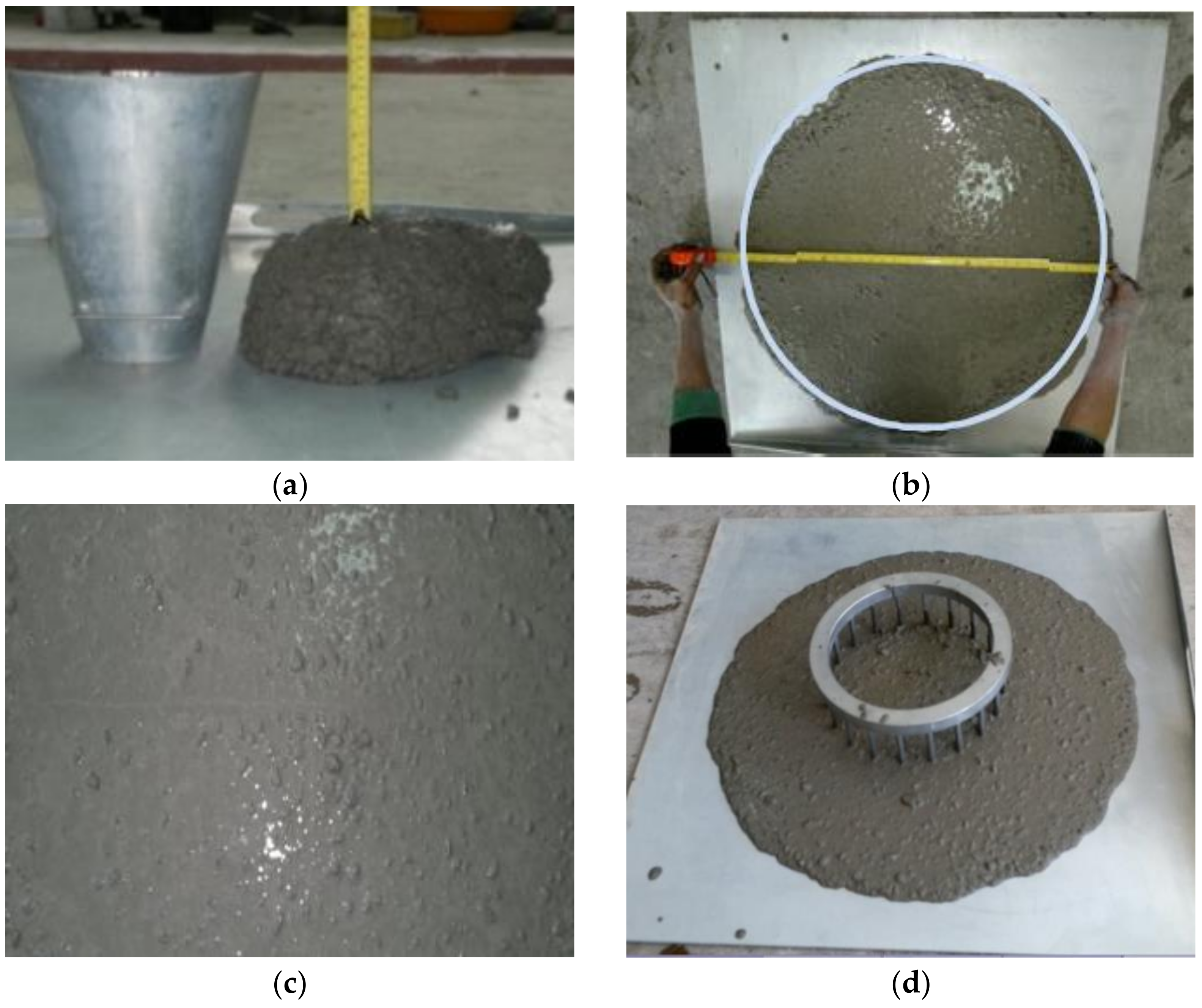

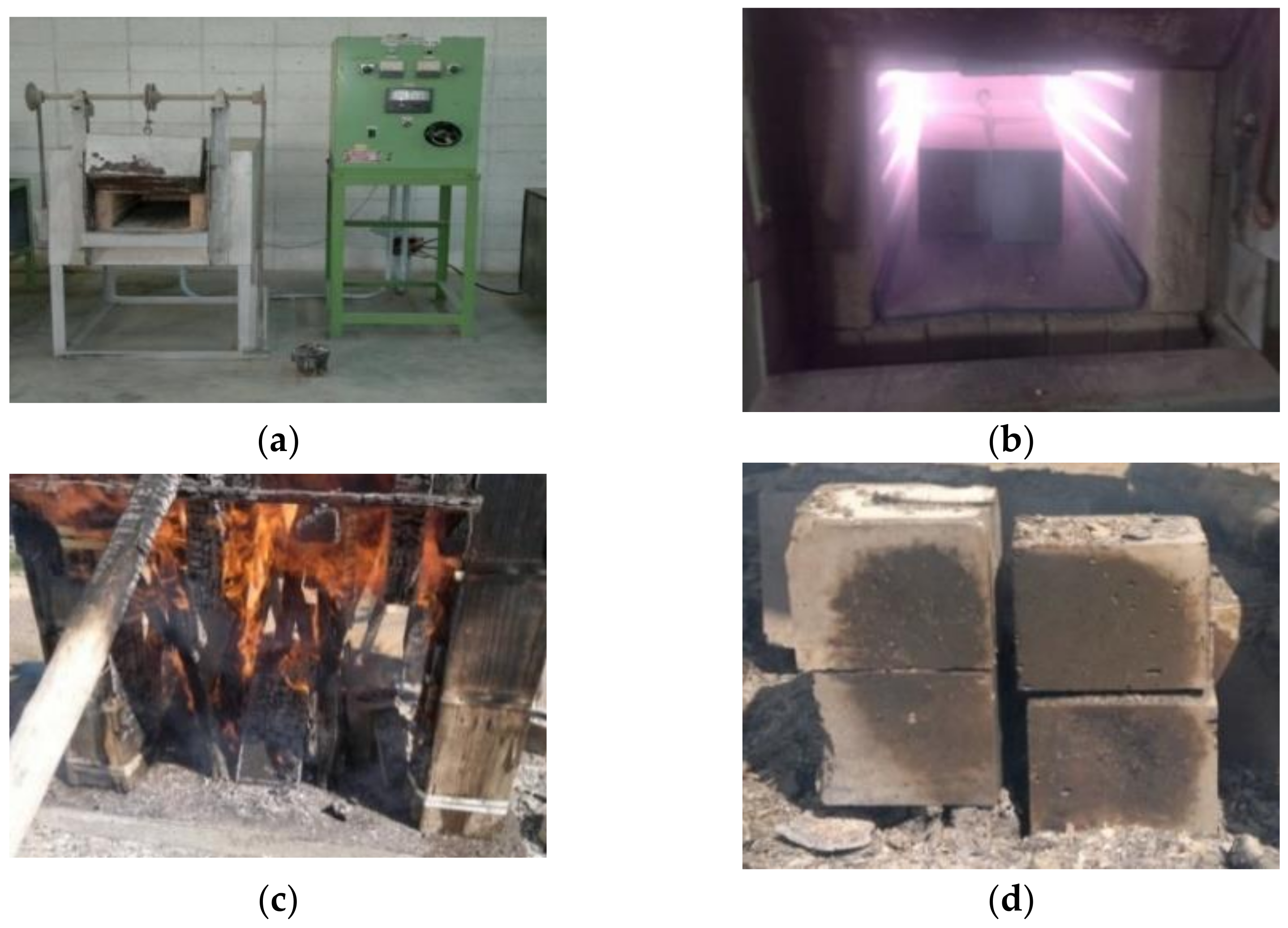
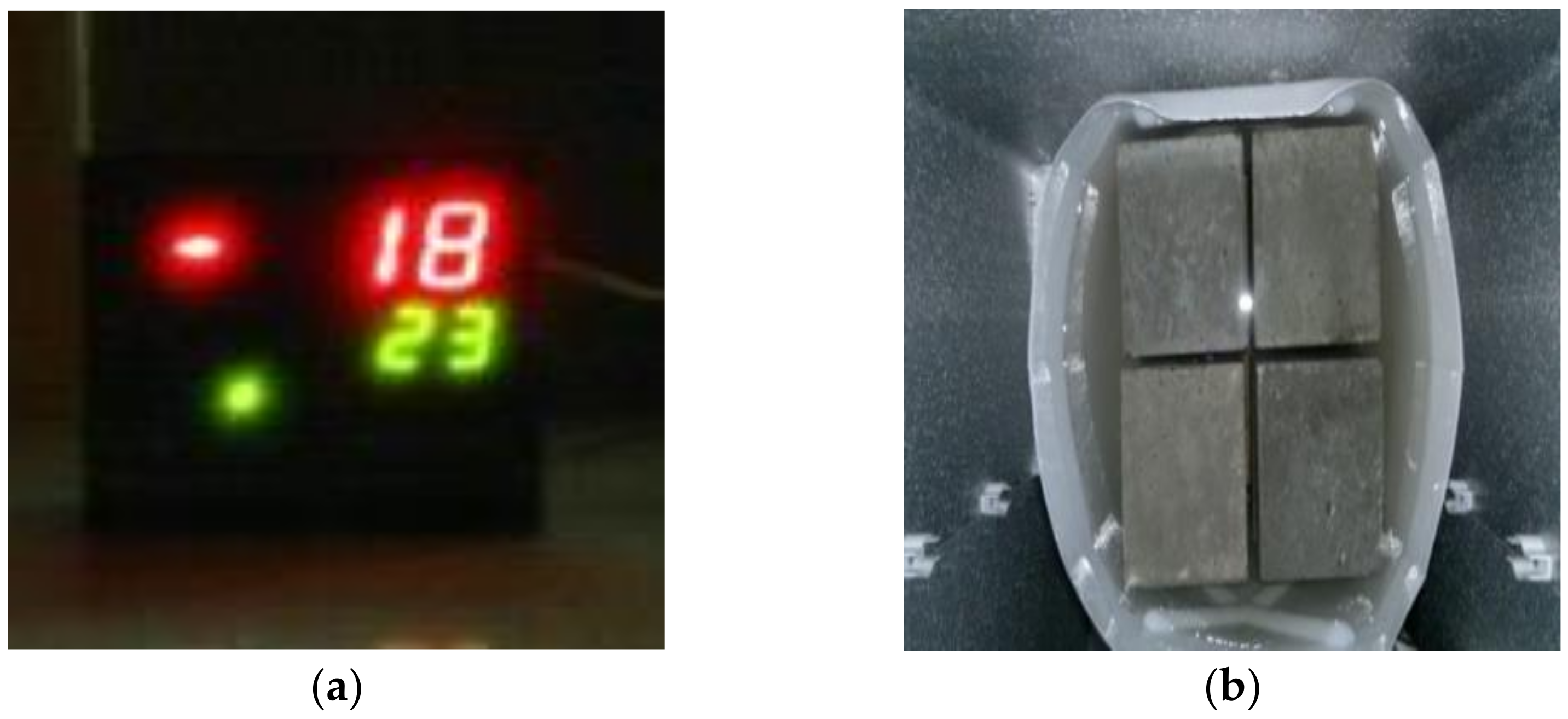
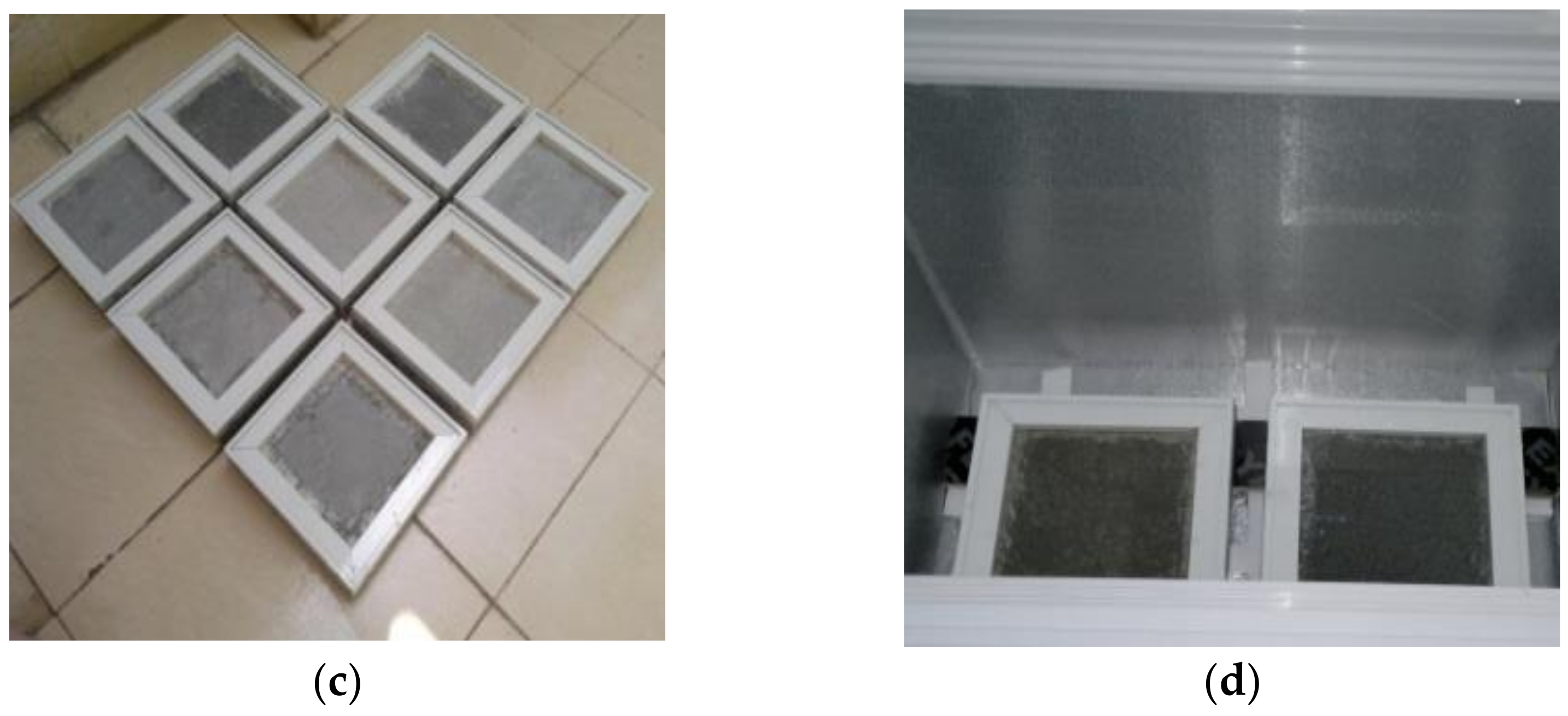
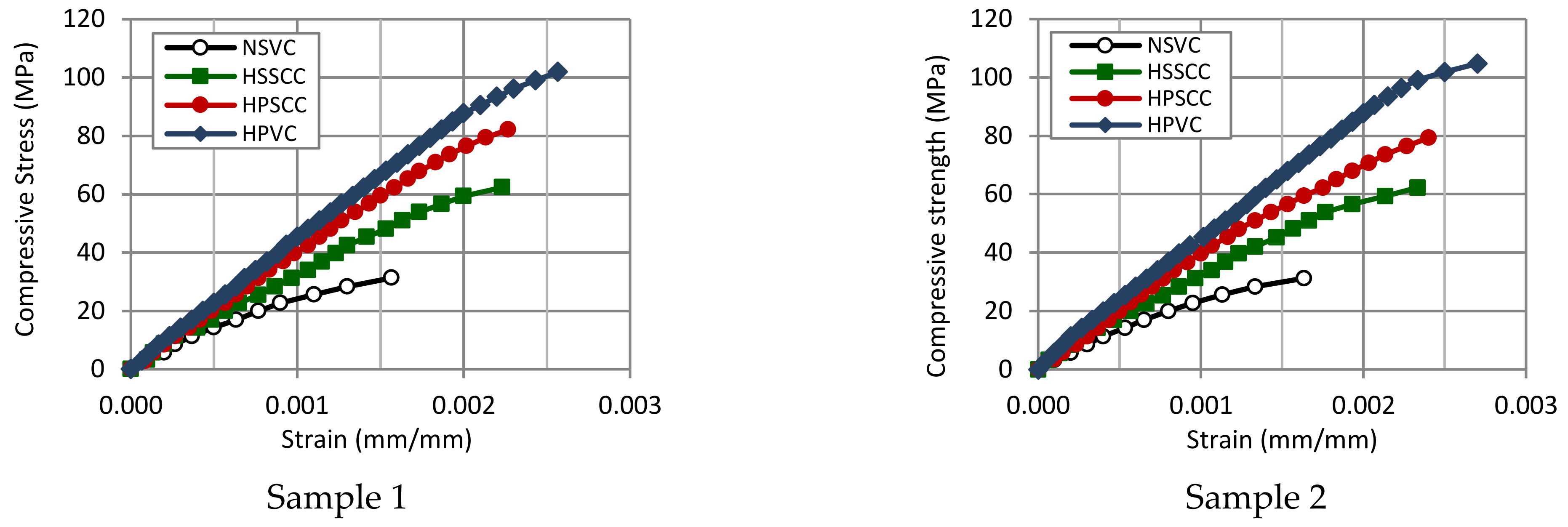
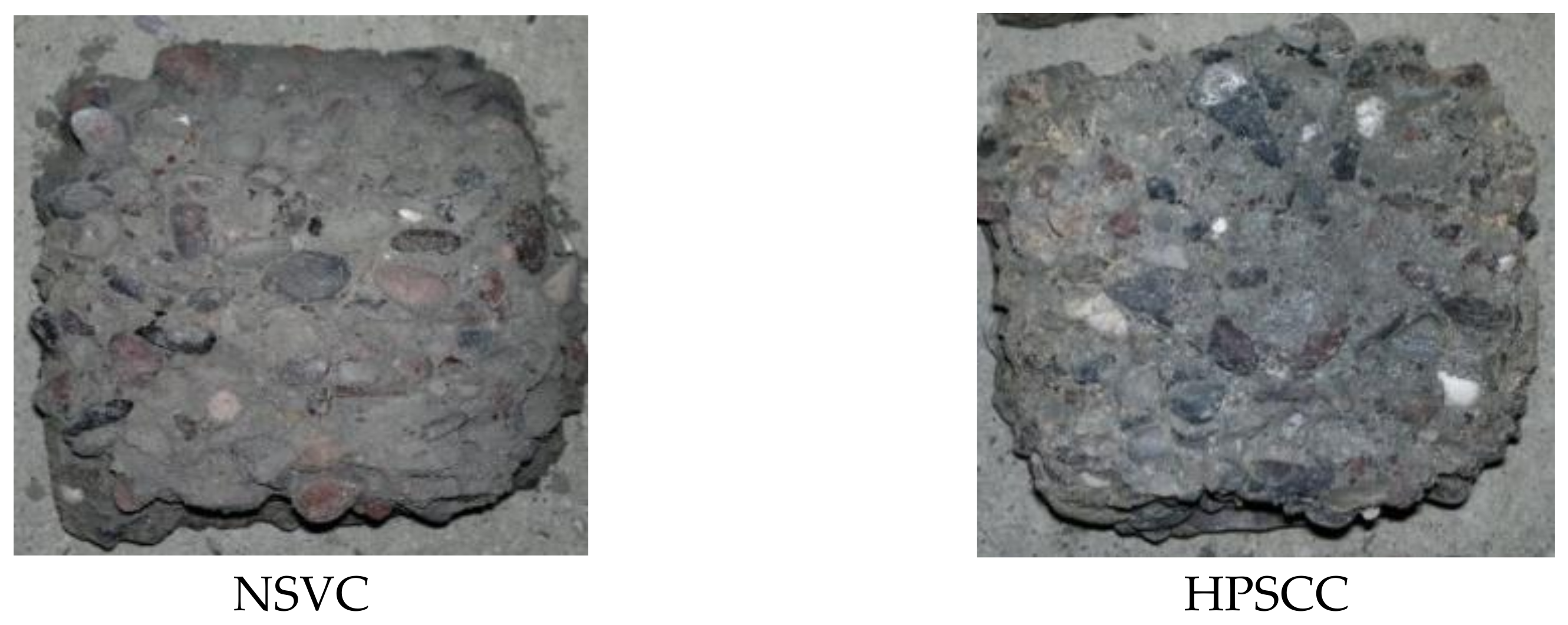
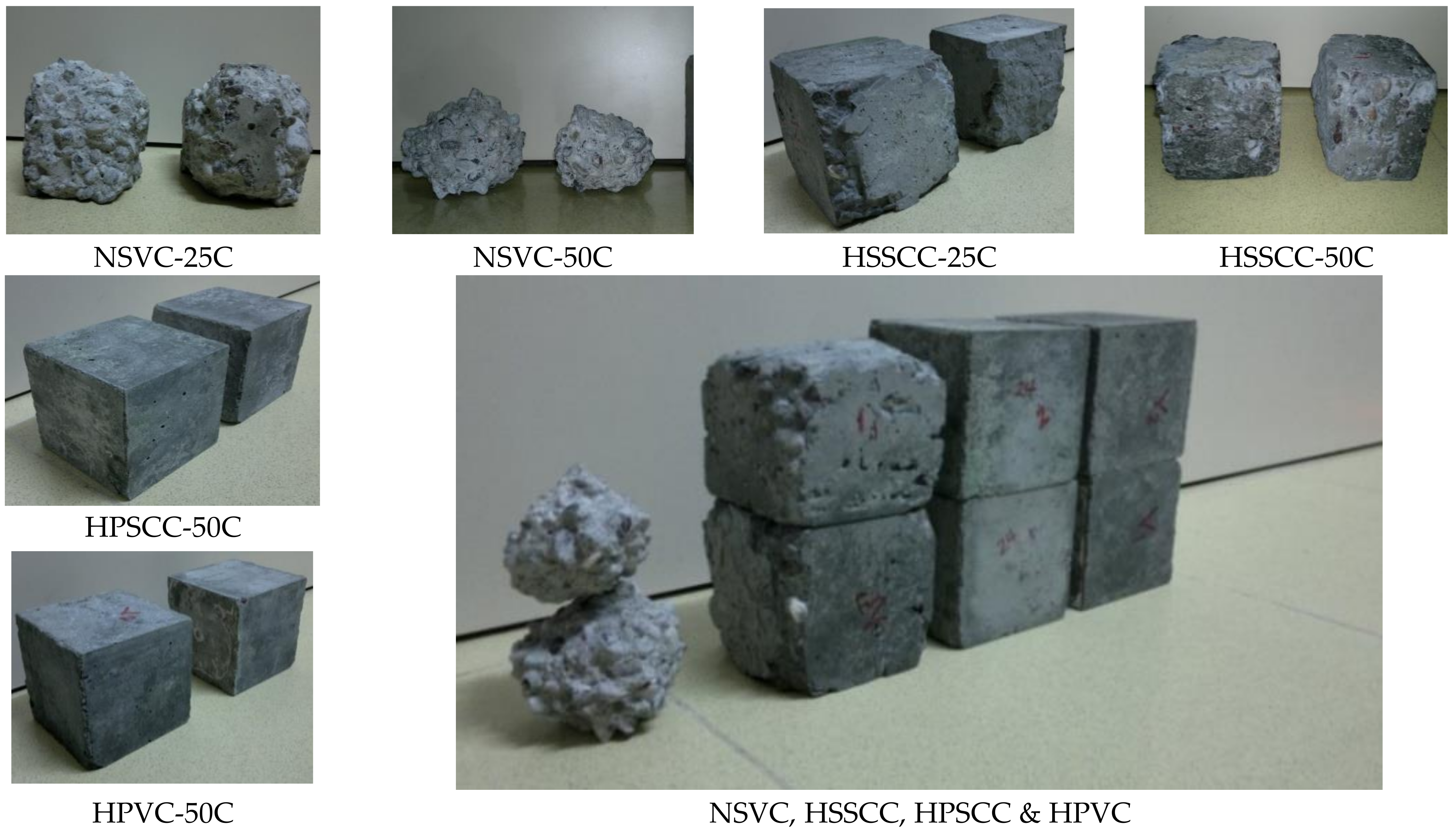
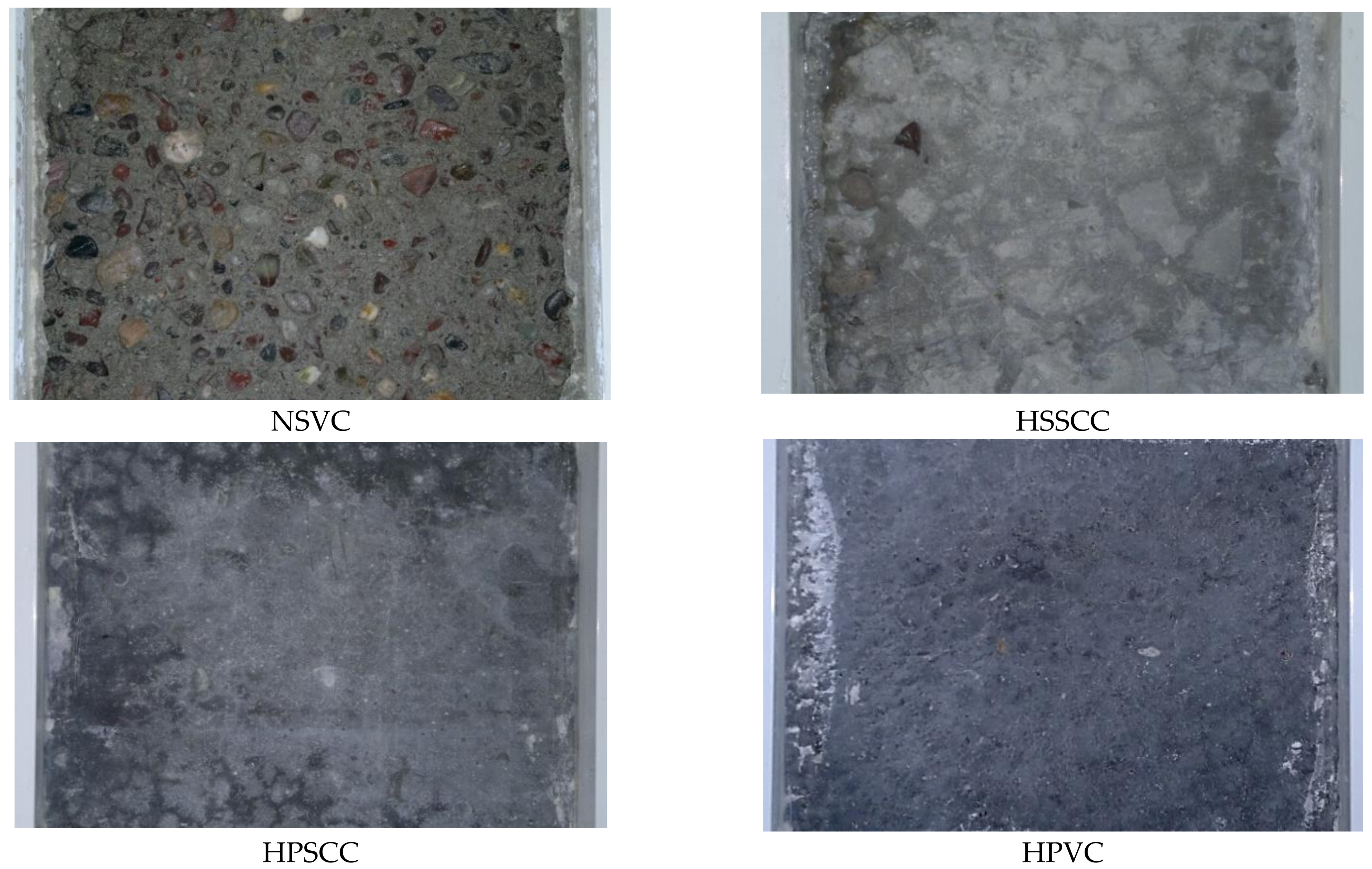
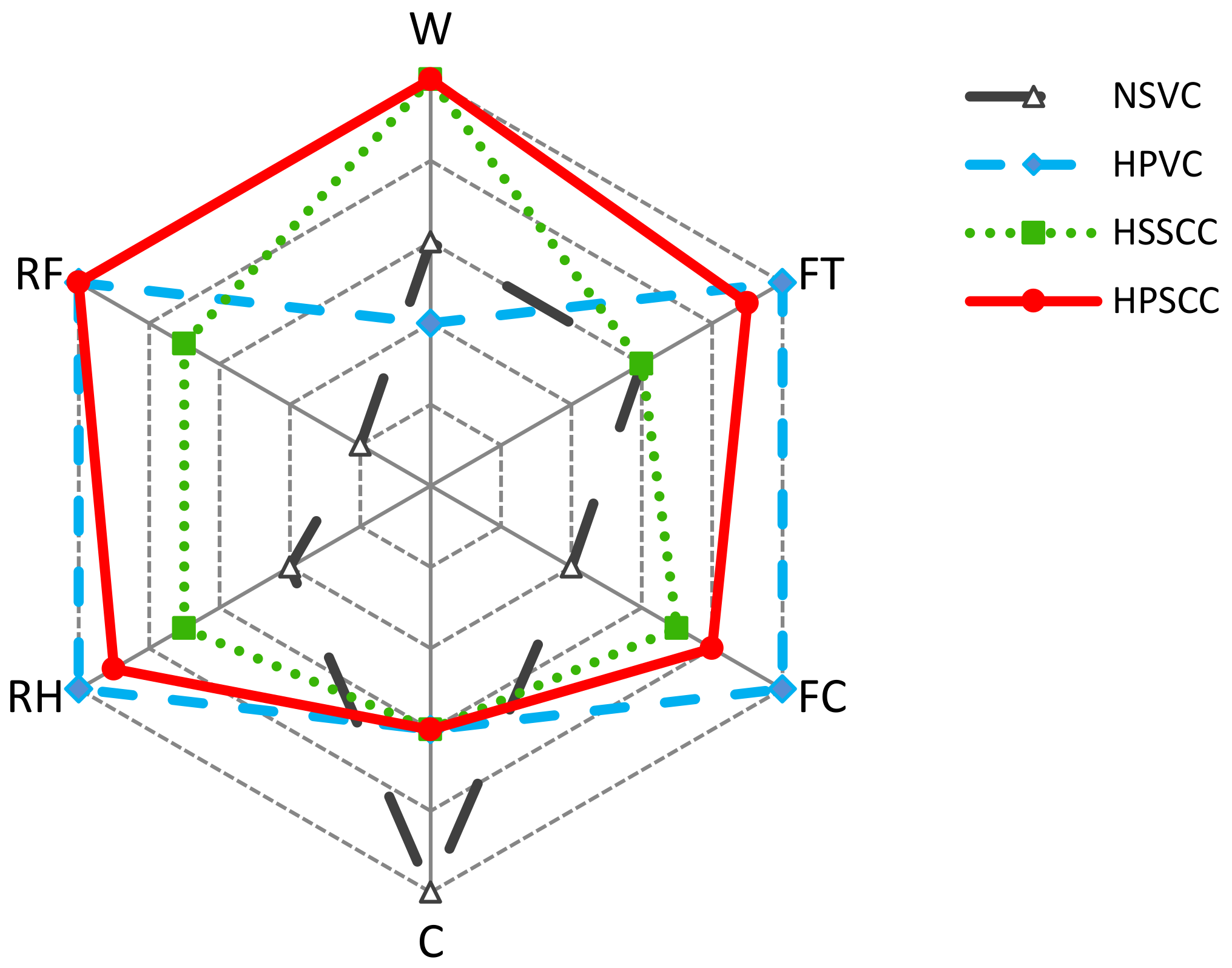
| Characteristics and Main Oxides | Cement | ASTM C150 | Micro-Silica | ASTM C1240 | Fly Ash | ASTMC 618 |
|---|---|---|---|---|---|---|
| CaO (%) | 63.12 | 0.34 | 1.43 | - | ||
| SiO2 (%) | 23.84 | 93.11 | ≥85.0 | 57.32 | [∑ (SiO2 + Al2O3 + Fe2O3) = 88.9 > 70] | |
| Al2O3 (%) | 4.32 | 0.62 | - | 19.88 | ||
| Fe2O3 (%) | 3.36 | 1.28 | - | 11.67 | ||
| MgO (%) | 1.38 | ≤6.0 | 1.04 | - | 1.36 | - |
| SO3 (%) | 1.89 | ≤3.0 | 0.34 | - | 0.79 | ≤5.0 |
| Na2O (%) | - | 0.28 | - | - | ||
| H2O (%) | - | 1.08 | ≤3.0 | 0.24 | ≤3.0 | |
| Insoluble residue (%) | 0.74 | ≤1.5 | - | - | ||
| LOI (%) | 1.63 | ≤3.0 | 0.83 | ≤6.0 | 2.28 | ≤6.0 |
| Initial setting time (min) | 140 | ≥45 | - | - | - | - |
| Final setting time (min) | 245 | ≤375 | - | - | - | - |
| Compressive strength in 3 days (MPa) | 34.1 | ≥12.0 | - | - | - | - |
| Compressive strength in 7 days (MPa) | 42.7 | ≥19.0 | - | - | - | - |
| Specific gravity | 3.15 | 2.64 | - | 2.32 | - | |
| Fineness (m2/kg) | 316.2 | ≥160 | 21,700 | ≥15,000 | - | - |
| Material/Sieve Size (mm) | Coarse Aggregate (%) | ASTM C33-G7 Limits (%) | Fine Aggregate (%) | ASTM C33 Limits (%) |
|---|---|---|---|---|
| 19 | 100 | 100 | ||
| 12.5 | 94 | 90–100 | ||
| 9.5 | 58 | 40–70 | 100 | 100 |
| 4.75 | 1 | 0–15 | 98 | 95–100 |
| 2.36 | 0 | 0–5 | 84 | 80–100 |
| 1.18 | 64 | 50–85 | ||
| 0.6 | 38 | 25–60 | ||
| 0.3 | 16 | 5–30 | ||
| 0.15 | 4 | 0–10 | ||
| 0.075 | 0 | 0–3 | ||
| Fineness Modulus | 3 | 2.3–3.1 |
| Mix | Cement | Concrete Composition | Concrete Granular Structure | Variation in the Comparison Parameters | |||||||||||
|---|---|---|---|---|---|---|---|---|---|---|---|---|---|---|---|
| kg/m3 | C | S | G | MS | FA | SP | S/G | B/A | W/B | Ad/C | Workability | Strength | Cost | Durability | |
| NSVC (Reference) | 316 | 316 | 848 | 1137 | - | - | 3.16 | 0.782 | 0.16 | 0.60 | 0.00 | VC | Low | Low | Low |
| HPSCC | 433 | 433 | 909 | 1039 | 35 | - | 4.33 | 0.875 | 0.24 | 0.35 | 0.08 | SCC | High | Normal | High |
| HSSCC | 396 | 396 | 831 | 950 | - | 158 | 3.96 | 0.875 | 0.31 | 0.35 | 0.40 | SCC | High | Normal | Normal |
| HPVC | 457 | 457 | 960 | 1096 | 55 | - | 4.57 | 0.875 | 0.24 | 0.23 | 0.12 | VC | Extra-high | High | High |
| Slump test results | Mix | NSVC | HPVC | |
| Slump | (mm) | 190 | 155 | |
| Stabilization time | (s) | 3 | 8 | |
| Average base diameter | (mm) | 405 | 345 | |
| Slump flow test results | Mix | HPSCC | HSSCC | |
| Segregation Index | (SI) | 0 | 0 | |
| Average flow diameter | (mm) | 810 | 750 | |
| T500 | (s) | 2.6 | 3.8 | |
| Restricted flow test results | Mix | HPSCC | HSSCC | |
| Flow diameter | (mm) | 760 | 740 | |
| T500 | (s) | 3.6 | 4.1 | |
| ΔH (inside & outside) | Avg. (mm) | 3.7 | 4.5 | |
| Accepted limit (mm) | 0–10 | 0–10 | ||
| Mix | Density of Cubic Specimens (kg/m3) | Density of Tile Shaped Specimens at 28 Days (kg/m3) | Tile Specimens Difference with the Cubes (%) | Absorption (%), at 28 Days | |||||
|---|---|---|---|---|---|---|---|---|---|
| 28 Days | 180 Days | Wt. Loss (%) | |||||||
| Avg. | SD | Avg. | SD | Avg. | SD | ||||
| HPSCC | 2475 | 13.5 | 2437 | 10.2 | 1.52 | 2507 | 8.4 | +1.29 | 0.97 |
| HSSCC | 2393 | 11.9 | 2381 | 10.6 | 0.50 | 2417 | 8.0 | +1.00 | 2.09 |
| NSVC | 2417 | 19.3 | 2357 | 17.3 | 2.48 | 2459 | 15.6 | +1.74 | 2.32 |
| HPVC | 2534 | 16.9 | 2483 | 15.8 | 2.00 | 2526 | 12.5 | −0.32 | 0.57 |
| Mix | Compressive Strength (MPa) of 100 mm Cubic Specimens (fcu) in (t) Days (Gained Strength in Percent Relative to 90 Days’ Strength) | Compressive Strength (MPa) of Ø100 mm Cylinders (fcy) at 90 Days | fcy/fcu at 90 Days | ||||||
|---|---|---|---|---|---|---|---|---|---|
| 1 Day | 3 Days | 7 Days | 28 Days | 56 Days | 90 Days | 180 Days | |||
| HPSCC | 20.9 (21) | 38.6 (39) | 58.1 (58) | 79.4 (79) | 94.4 (94) | 100.2 (100) | 104.4 (104) | 90.3 | 0.901 |
| HSSCC | 8.4 (10) | 31.3 (38) | 46.0 (55) | 59.9 (72) | 74.8 (90) | 82.9 (100) | 86.2 (104) | 71.3 | 0.860 |
| NSVC | 4.5 (08) | 11.8 (22) | 17.5 (33) | 34.6 (65) | 46.2 (86) | 53.6 (100) | 55.3 (103) | 42.6 | 0.794 |
| HPVC | 30.2 (25) | 48.9 (40) | 67.8 (56) | 103.5 (85) | 116.2 (95) | 121.9 (100) | 126.7 (104) | 117.5 | 0.964 |
| Mix | Compressive Strength | Splitting Tensile Strength | Flexural Strength | Modulus of Elasticity | ||||||||
|---|---|---|---|---|---|---|---|---|---|---|---|---|
| fcy (MPa) | ft (MPa) | fct/fcy (%) | ft/√fcy | fr (MPa) | ft (MPa) | fr/ft | fr/√fcy | SP1 (MPa) | SP2 (MPa) | E (MPa) | E/√f’c | |
| HPSCC | 90.3 | 6.21 | 6.88 | 0.654 | 7.15 | 6.21 | 1.151 | 0.752 | 43.24 | 42.10 | 42.7 | 4.49 |
| HSSCC | 71.3 | 4.60 | 6.45 | 0.545 | 4.82 | 4.60 | 1.047 | 0.571 | 32.91 | 32.65 | 32.8 | 3.88 |
| NSVC | 42.6 | 4.05 | 9.51 | 0.621 | 4.45 | 4.05 | 1.098 | 0.682 | 27.94 | 27.78 | 27.9 | 4.27 |
| HPVC | 117.5 | 7.19 | 6.12 | 0.663 | 8.41 | 7.19 | 1.169 | 0.776 | 45.31 | 46.00 | 45.7 | 4.22 |
| Mix | The Resistance of Specimens Exposed to High Temperature | The Resistance of Specimens Exposed to Direct Fire | |||||||||
|---|---|---|---|---|---|---|---|---|---|---|---|
| Weight (g) | Compressive Strength (MPa) | Compressive Strength (MPa) | |||||||||
| Dry in 60 °C | Heated to 700 °C | Weight Loss (%) | Control Cubes | Heated Cubes | Residual Strength (%) | Strength loss (%) by Heating (700 °C) | Control Cubes | Cubes Exposed to Fire (500 °C) | Residual Strength (%) | Strength Loss (%) | |
| HPSCC | 2462 | 2317 | 5.89 | 93.2 | 44.9 | 48.2 | 51.8 | 93.2 | 73.2 | 78.5 | 21.5 |
| HSSCC | 2401 | 2238 | 6.79 | 68.2 | 25.4 | 37.3 | 62.7 | - | - | - | - |
| NSVC | 2403 | 2222 | 7.53 | 44.0 | 9.4 | 21.4 | 78.6 | 44.0 | 29.0 | 65.8 | 34.2 |
| HPVC | 2516 | 2379 | 5.45 | 105.4 | 53.9 | 51.1 | 48.9 | - | - | - | - |
| Mix | HPSCC | HSSCC | NSVC | HPVC | ||
|---|---|---|---|---|---|---|
| Loss in mass and compressive strength for 100 mm concrete cubes due to freeze-thaw cycles | Mass loss (%) after | 10 cycles | 0 | 5.19 | 5.43 | 0 |
| 25 cycles | 0.02 | 5.67 | 22.94 | 0 | ||
| 50 cycles | 0.02 | 6.13 | 82.64 | 0.02 | ||
| Compressive strength (MPa) | Control cubes | 109.8 | 90 | 56.1 | 130.2 | |
| After 50 cycles | 99.1 | 56.9 | 8.1 | 120.8 | ||
| Residual strength (%) | 90.3 | 63.2 | 14.4 | 92.8 | ||
| Mass losses of concrete specimens at the scaling test, and wearing of the concrete surface due to freeze-thaw cycles | Initial mass (kg) | 0 cycles | 12.591 | 12.048 | 11.621 | 13.026 |
| Mass loss (%) after | 10 cycles | 0 | 0.62 | 1.87 | 0 | |
| 25 cycles | 0.01 | 0.87 | 6.83 | 0 | ||
| 50 cycles | 0.02 | 1.14 | 15.81 | 0.01 | ||
| 50 cycles weight loss | kg/m3 | 0.387 | 27.18 | 372.6 | 0.286 | |
| kg/m2 | 0.0194 | 1.359 | 18.631 | 0.014 | ||
| Scaling depth of exposed surface (mm) | 0.010 ≈ 0 | 0.570 ≈ 1 | 7.905 ≈ 8 | 0.005 ≈ 0 | ||
| Mix | Rating/No. of Cycles for the Tested Specimens | Ranking-Surface Conditions According to ASTM C672 | |||||
|---|---|---|---|---|---|---|---|
| 0 | 5 | 10 | 15 | 25 | 50 | ||
| NSVC | 0 | 1 | 2 | 3 | 4 | 5 | (0) No scaling; (1) Very slight scaling (3 mm depth, max, no coarse aggregate visible); (2) Slight to moderate scaling; (3) Moderate scaling (some coarse aggregate visible); (4) Moderate to severe scaling; (5) Severe scaling (coarse aggregate visible over the entire surface) |
| HPVC | 0 | 0 | 0 | 0 | 0 | 0 | |
| HSSCC | 0 | 1 | 2 | 2 | 2 | 3 | |
| HPSCC | 0 | 0 | 0 | 0 | 0 | 0 | |
| Mix | Strength, 90 Days | Durability, 90 Days | Workability, (mm) | Cost ($) | MPAS | ||||
|---|---|---|---|---|---|---|---|---|---|
| (MPa) | (%) | ||||||||
| Compressive Strength | Tensile Strength | Oven Residual Strength | Residual Strength in F/T Cycles | Slump or Slump Flow | Cost-Effectiveness | Average Out of 10 | Hexagon Area | Relative Area | |
| HPSCC | 100.2 | 6.21 | 48.2 | 90.3 | 810 | 135 | - | - | - |
| S.N. | 8 | 9 | 9 | 10 | 10 | 6 | 8.7 | 196.6 | 1 |
| HSSCC | 82.9 | 4.6 | 37.3 | 63.2 | 750 | 125 | - | - | - |
| S.N. | 7 | 6 | 7 | 7 | 10 | 6 | 6.1 | 132.1 | 0.67 |
| NSVC | 53.6 | 4.05 | 21.4 | 14.4 | 190 | 80 | - | - | - |
| S.N. | 4 | 6 | 4 | 2 | 6 | 10 | 5.3 | 69.3 | 0.35 |
| HPVC | 121.9 | 7.19 | 51.1 | 92.8 | 155 | 140 | - | - | - |
| S.N. | 10 | 10 | 10 | 10 | 4 | 6 | 8.3 | 173.2 | 0.88 |
Publisher’s Note: MDPI stays neutral with regard to jurisdictional claims in published maps and institutional affiliations. |
© 2021 by the authors. Licensee MDPI, Basel, Switzerland. This article is an open access article distributed under the terms and conditions of the Creative Commons Attribution (CC BY) license (http://creativecommons.org/licenses/by/4.0/).
Share and Cite
Ahmed, G.H.; Ahmed, H.; Ali, B.; Alyousef, R. Assessment of High Performance Self-Consolidating Concrete through an Experimental and Analytical Multi-Parameter Approach. Materials 2021, 14, 985. https://doi.org/10.3390/ma14040985
Ahmed GH, Ahmed H, Ali B, Alyousef R. Assessment of High Performance Self-Consolidating Concrete through an Experimental and Analytical Multi-Parameter Approach. Materials. 2021; 14(4):985. https://doi.org/10.3390/ma14040985
Chicago/Turabian StyleAhmed, Ghafur H., Hawreen Ahmed, Babar Ali, and Rayed Alyousef. 2021. "Assessment of High Performance Self-Consolidating Concrete through an Experimental and Analytical Multi-Parameter Approach" Materials 14, no. 4: 985. https://doi.org/10.3390/ma14040985
APA StyleAhmed, G. H., Ahmed, H., Ali, B., & Alyousef, R. (2021). Assessment of High Performance Self-Consolidating Concrete through an Experimental and Analytical Multi-Parameter Approach. Materials, 14(4), 985. https://doi.org/10.3390/ma14040985








